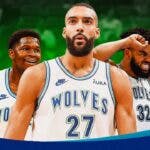Utah Jazz fans will not soon recover after Gordon Hayward ditched Salt Lake City and all the glory of its nightlife for Beantown. Hayward was largely viewed as not only the leader of the team, but the centerpiece of what the Jazz were trying to build — a championship team.
It took the Jazz years of cautious planning, hoping that the team would become a perennial title contender and ultimately be taking home the franchise’s first ever Larry O’Brien. Hayward was part of that entire plan before Danny Ainge and the Boston Celtics convinced the Butler product to play for them, ending arguably the biggest free agent saga in Jazz history. Without Hayward, the Jazz are bereft of a crucial note.
However, it’s not like the end of the world for Utah. The Jazz still got Rudy Gobert, who is now undeniably Utah’s alpha dog. Hayward’s departure has rendered unnecessary any debate concerning who between Hayward and Gobert is the team’s franchise player, though it has also given birth to a new one. That’s whether The Stifle Tower is more of a franchise player and less of just an important piece that makes a great group function — or vice versa.

If you consult FiveThirtyEight.com’s CARMELO projections, which basically is a system that tries to predict a player’s five-year future based on his age and stats, Gobert is going to be an All-Star worth around $235 million. No one is contesting Gobert’s great future value, however, and that being labeled an All-Star shouldn’t be mistaken for another way to say franchise player because there was a time when Mehmet Okur was an All-Star.
Most franchise players are terrific offensive weapons. Rarely are they the defensive specialist like Gobert, whose offense is mostly reliant on putbacks, lobs, pick-and-rolls, and other plays that are too dependent on other players' initiatives. He won’t stretch the floor with his perimeter touch nor will he destroy souls in the post (just 0.5 points in the post per possession last season). Ricky Rubio‘s problematic jumper and passing wizardry may give Gobert extra scoring opportunities on the offensive glass and on half-court setups but the bulk of his offense is unlikely to come from him individually breaking down his defender.

Despite a limited offensive skillset, Gobert was able to pace Utah in win shares (14.3) in 2016-2017 because what he lacks in that area, he makes up on the other side of the ball. Gobert’s 6.0 defensive win shares were not only best in the team but in the league as well, even better than Defensive Player of the Year winner Draymond Green’s.
He is arguably the most intimidating rim protector today. His 2.6 blocks per game was number one last season and that’s not factoring the countless shots he’s altered at the rim. According to NBA Stats’ page, opponents shot 12.8 percent worse within six feet of the basket when Gobert is on the floor. Knowing this, opponents would rather chuck the ball from range for lower percentage shots, plenty of which end up as misses that Gobert converts to rebounds.
Gobert averaged just 2.3 points, 3.4 rebounds, and 0.2 blocks in 2013-2014 – his rookie year. Last season, those numbers expanded to 14.0 points, 12.8 rebounds.
It doesn’t feel right to call Rudy Gobert a franchise player just yet, but as far as potential, he certainly has it and perhaps another strong season with an improved offense would help his case.




